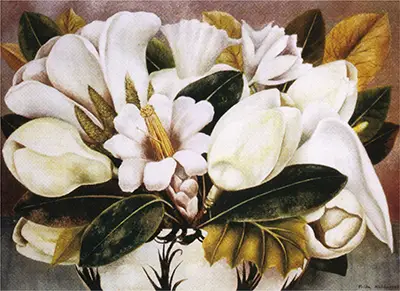It is now a part of the Balbina Azcárraga Collection in Mexico City, the capital of Mexico. Kahlo followed the so-called Naïve Folk Art (Primitivism) style in this work. Most of her paintings in the genre of still-life were inspired by the natural beauty of her beloved homeland. In this picture, she captures very well the fresh and clean beauty of the magnolia tree or bush with their large, typically creamy-pink, and waxy flowers, and widely grown as ornamental plants.
The virtue of Magnolias indeed lies mainly in its simplicity, augmented by its not so obvious deeper symbolic meaning. The magnolia flower traditionally represents dignity and nobility, two major issues facing Mexico's indigenous peoples in a post-colonial political setting. In Ancient China, magnolias symbolised perfect female beauty and gentleness. In the southern states of the U.S.A., white magnolias are commonly included in wedding bouquets because they emphasise the bride's purity.
Clearly, Kahlo's painting was influenced, perhaps even inspired by, the globally acclaimed American modernist artist, Georgia O'Keeffe (1887-1986). Indeed, O'Keeffe painted a picture of the same subject matter. However, whereas the latter's version depicts the flower in full bloom, the former's magnolias are only in the bud stage, and there is a large very fragile and ephemeral pear cactus flower in the middle of Kahlo's composition.
Frida often used this exquisite local flower in her creations as a symbol of the fragility between life and death. In addition, to the right of the arrangement is another example of elegant Mexican flora, a partially hidden open calla lily, known to have been the favourite flower of her husband, Diego Rivera, because of its whiter than white colour, and included in many of his paintings. Frida Kahlo was once quoted as saying, "Feet, what do I need you for when I have wings to fly?". This imaginatively reflects the freedom of expression she was able to achieve through her art.

